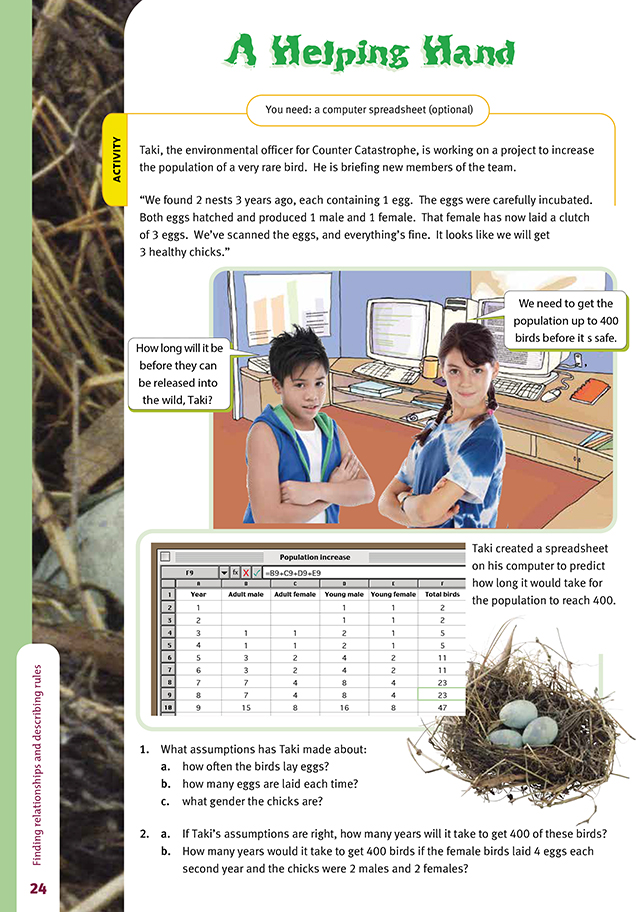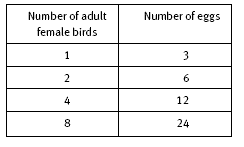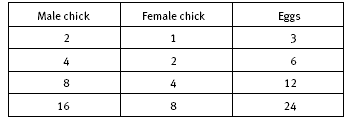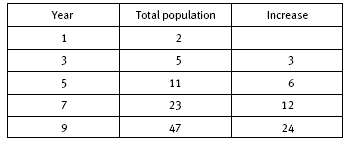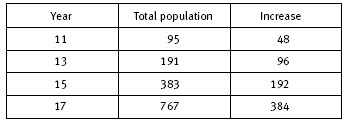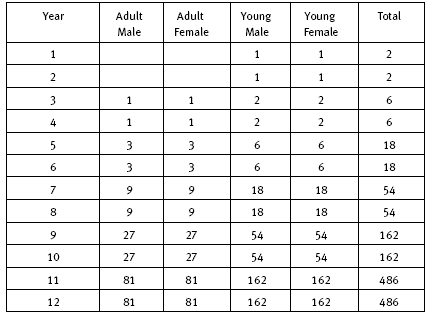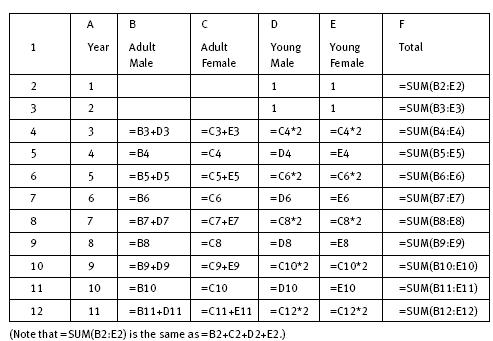This is a level 4 algebra activity from the Figure It Out theme series.
A PDF of the student activity is included.
Click on the image to enlarge it. Click again to close. Download PDF (395 KB)
identify a number pattern from the pattern
FIO, Levels 4-4+, Theme: Disasters Strike!, A Helping Hand, page 24
A computer spreadsheet (optional)
The most important task for any teacher in helping students to see patterns in number sequences is to show the students how to look at what’s important to the problem. The students are asked to comment on how often the birds lay their eggs. Nothing has been said about the gender of the eggs, just how many. So all we need to study is the total column on Taki’s spreadsheet, and there we see that the total bird population increases only every 2 years. Therefore, eggs hatch only every 2 years.
To determine how many eggs are laid every year, we need to look at who lays the eggs. Only the female birds can do this. So, when we had 1 female adult bird, the population increased by 3. On this basis, 2 female adults would have 6 chicks. Summarising this information, we have:
Looking at the gender of the chicks, we find that there is an obvious pattern in which two-thirds of the eggs are male and one-third is female.
To predict the number of years before the bird population reaches 400 birds, we study the number pattern for the total. It can be summarised as follows:
We notice that the increase in population at each “egg hatch” is double the increase of the previous year. So we can complete the table as follows:
If there were 4 chicks and half of them were of each gender, as in question 2b, the spreadsheet would look like this:
Given this scenario, the number 400 is reached in 11 years.
While all the above reasoning has been done by extracting data from the table provided, the students would benefit from modelling the situation on a spreadsheet. Wherever possible, use the rules above and apply them to cell formulae when creating the spreadsheet rather than manually calculating and entering the numbers one by one. This will enable the spreadsheet to be manipulated by the students to see the effects of a change in birth patterns.
Below is a spreadsheet showing all the cell formulae:
Cross-curricular links
Science
Students who are interested in science generally, or in native fauna and endangered species in particular, will probably realise that this activity presents a simplified mathematical model for saving endangered species rather than an actual result. This could create useful classroom discussion or even a project. The students
could investigate the way mathematics is used to find reasonable estimates and explore the variables and uncertainties that are involved in such estimates.
Achievement Objectives
• investigate and describe special features of animals or plants which help survival into the next generation (Living World, level 4)
• investigate a local environmental issue and explain the reasons for the community’s involvement (Planet Earth and Beyond, level 4)
Answers to Activity
1. a. It takes 3 years before the birds are adult and can lay their first eggs. After that, they lay every second year.
b. 3 eggs are laid each time by every adult female, and all survive.
c. 2 male and 1 female each time to each adult female.
2. a. After 17 years, there will be 767 birds (excluding any deaths).
b. After only 11 years, there will be 486 birds (excluding any deaths).
